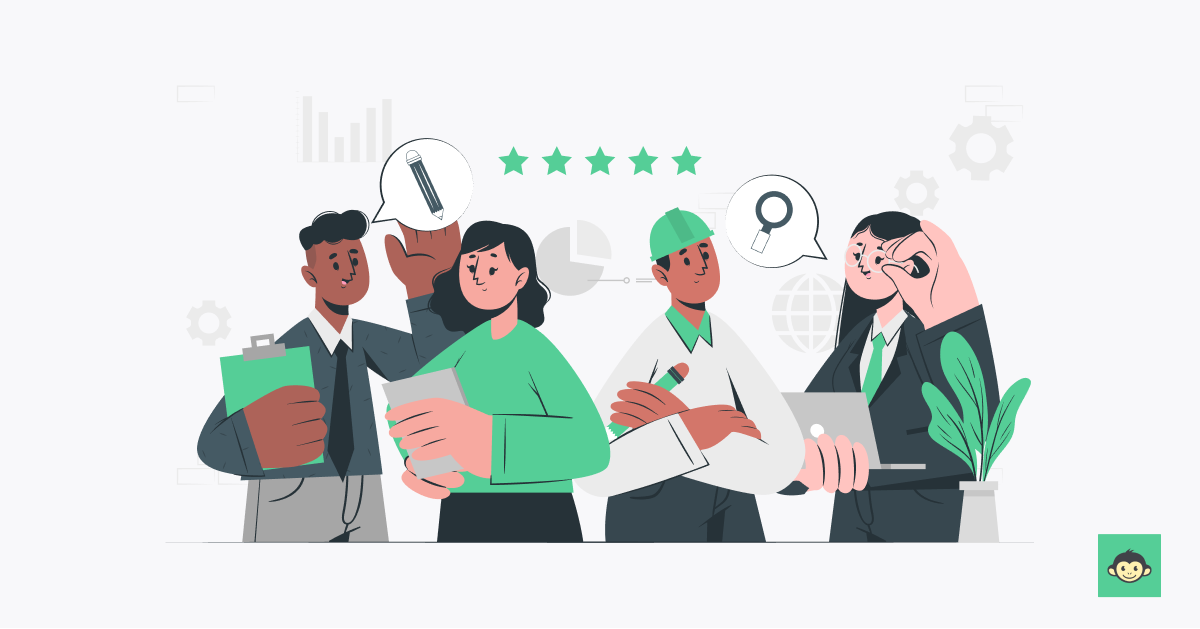What are the key principles of employee experience: Best practices to transform your company culture in 2024

In this age of remote work, ping-pong tables, and endless Slack notifications, the landscape of the workplace is evolving faster than you can say "casual Fridays." But fret not because we're here to guide you through the tangled vines of employee experience.
As the wise sage of workplace wisdom, Steve Jobs, once said, "Your work is going to fill a large part of your life, and the only way to be truly satisfied is to do what you believe is great work. And the only way to do great work is to love what you do."
Now, ain't that the truth? Our journey through the principles of optimal employee experience starts with this nugget of insight – the heart of the matter lies in creating an environment where passion meets the profession.
In this blog, we will dive into the details of what makes the employee experience thrive, exploring the vital principles that not only make your team want to punch the clock but actually look forward to Monday mornings.
What is employee experience?

Employee experience encapsulates every interaction, emotion, and touchpoint an employee has with their workplace. It's the sum total of their journey, from the initial onboarding rituals to the daily grind, collaborative projects, and even those coffee-break chats that become the highlight of the day.
It's about more than just a job; it's an employee's work life, about the vibe, the culture, the relationships, and the overall ambiance that shapes their professional adventure.
Think of it as crafting an unforgettable play – the script (company policies), the set design (work environment), the co-stars (colleagues), and the director (leadership) all play pivotal roles.
When these elements harmonize, you've got a blockbuster production where employees aren't just punching the clock but actively participating in a storyline they're passionate about.
So, employee experience isn't a one-size-fits-all concept; it's a bespoke suit tailored to fit the unique contours of your organization, ensuring that each employee feels seen, valued, and excited about their role in the grand performance of the workplace.
Principles of employee experience objectives

Let's delve into the key objectives that form the bedrock of a stellar employee experience.
1. Cultivate a culture of belonging
- Objective: Foster an environment where employees feel a sense of belonging and inclusivity.
- Why it Matters: A workplace where individuals feel valued for their unique contributions cultivates a positive atmosphere, boosting morale and collaboration.
2. Prioritize employee well-being
- Objective: Establish programs and policies that prioritize physical and mental well-being.
- Why it Matters: A healthy workforce is a productive workforce. Supporting well-being not only enhances job satisfaction but also reduces burnout and absenteeism.
3. Empower through growth and development
- Objective: Provide opportunities for continuous learning and professional development.
- Why it Matters: Empowered employees are engaged employees. Investing in growth fosters a culture of innovation, adaptability, and loyalty.
4. Transparent communication
- Objective: Foster open and transparent communication channels throughout the organization.
- Why it Matters: Clarity in communication builds trust, aligns teams with organizational goals, and reduces the likelihood of misunderstandings.
5. Recognition and appreciation
- Objective: Implement a robust recognition system to acknowledge and appreciate employees' contributions.
- Why it Matters: Regular recognition not only boosts morale but also creates a positive feedback loop, reinforcing behaviors that contribute to the organization's success.
6. Flexible Work Environment
- Objective: Offer flexibility in work arrangements to accommodate diverse needs.
- Why it Matters: A flexible work environment promotes work-life balance, increases job satisfaction, and attracts a wider pool of talent.
7. Leadership development
- Objective: Invest in leadership training and development programs.
- Why it Matters: Effective leadership sets the tone for the entire employee experience. Developing strong leaders enhances team dynamics and overall organizational success.
8. Align employee values with company values
- Objective: Ensure alignment between the personal values of employees and the core values of the company's central being.
- Why it Matters: When values align, employees feel a deeper connection to the company's mission, fostering a sense of purpose in their work.
What are the key principles of employee experience?
Let's explore the key principles that form the foundation of a remarkable employee experience:
- Tailor the employee experience to individual needs and preferences.
- View the employee experience as a continuous journey from recruitment to offboarding.
- Communicate and embody the company's purpose and values.
- Foster a culture of collaboration and teamwork.
- Establish mechanisms for ongoing feedback and actively work on improvements.
- Demonstrate empathy and provide support to employees in both personal and professional aspects.
- Cultivate leaders who prioritize inclusivity and diversity.
- Leverage technology to enhance and simplify the employee experience.
What are the dimensions of employee experience?

There are multiple dimensions of employee experience. Let's take a look at them.
- Physical environment: The tangible workspace, encompassing the layout, design, and amenities of the office, significantly impacts the comfort and well-being of employees.
- Cultural environment: The shared values, beliefs, and norms that shape the organizational culture influence how individuals perceive their roles and interact within the workplace.
- Technological environment: The tools, software, and technology infrastructure provided to employees affect their efficiency, communication, and overall experience in executing their responsibilities. For example, the company's employee learning interface should be well-optimized.
- Professional growth: Opportunities for skill development, career advancement, and continuous learning reflect the organization's commitment to the individual growth and progression of its employees.
- Relationships and collaboration: The quality of interactions and relationships among colleagues, teams, and management influences the collaborative spirit and overall social dynamics within the workplace.
- Recognition and feedback: The acknowledgment of employees' achievements, along with the frequency and effectiveness of feedback mechanisms, contributes to a culture of appreciation and continuous improvement.
- Work-life balance: The equilibrium between professional and personal life, including policies, practices, and support systems that enable employees to maintain a healthy balance between their work and personal responsibilities.
- Leadership and management: The effectiveness of leadership and management practices in guiding, motivating, and supporting employees impacts the overall organizational culture and employee experience.
- Total rewards: The comprehensive package of compensation, benefits, and other rewards provided to employees influences their motivation, satisfaction, and commitment to the organization. This means the company's expense management system should not lead to poor employee experiences.
- Employee voice and inclusion: The extent to which employees feel empowered to express their opinions and the organization's commitment to creating an inclusive environment that values diverse perspectives.
- Health and well-being: The organization's initiatives and support systems promote both physical and mental well-being among employees and contribute to a positive and resilient workforce.
- Onboarding and offboarding: The employee experience strategy both during the entry and exit phases of employment, including the effectiveness of onboarding processes and the support provided during offboarding or transitions.
How to measure your employee experience at work?

Measuring employee experience goes beyond functional or administrative needs and is akin to capturing the heartbeat of your organization – it requires a nuanced approach that goes beyond traditional metrics.
Begin by conducting regular surveys to gauge employee satisfaction, employee engagement, and overall sentiment. These surveys should delve into various dimensions, from workplace culture and leadership effectiveness to the effectiveness of communication channels.
Consider implementing pulse surveys to capture real-time feedback on specific initiatives or changes. This agile method ensures robust and ongoing feedback so you stay attuned to the evolving needs and sentiments of your workforce and get operational data to act upon.
Additionally, analyze turnover rates, as a high churn may signal underlying issues in the employee experience.
Tap into qualitative data through one-on-one interviews or focus groups. These conversations provide deeper insights into individual employee experiences, allowing you to address nuanced concerns. Utilize employee feedback platforms and social channels to encourage open dialogue and collect real-time opinions.
Moreover, leverage key performance indicators (KPIs) tied to organizational goals, such as productivity, innovation, and customer satisfaction. A positive employee experience often correlates with improved business outcomes.
Lastly, track the success of employee development programs and initiatives, as these directly impact professional growth and satisfaction.
By amalgamating quantitative and qualitative data, you create a comprehensive understanding of your organization's employee experience, enabling targeted improvements and fostering a workplace where your team can truly thrive.
Remember that highly connected employee experiences will help your organization thrive
7 Best practices to transform your employee experience in 2024

Let’s take a look at the best practices that will transform your business leaders' and organizations' employee experience in the upcoming year.
- Holistic well-being initiatives: Prioritize physical and mental health with comprehensive well-being programs, fostering a supportive environment that values the whole employee.
- Technology integration for seamless work: Embrace cutting-edge tools to streamline processes, enhance collaboration, and create a tech-savvy workplace that empowers employees to excel.
- Flexible work models: Emphasize flexible work arrangements, recognizing the importance of work-life balance and catering to diverse employee needs and preferences.
- Continuous learning and development: Invest in ongoing training, providing employees with opportunities for skill enhancement and career progression in the rapidly evolving professional landscape.
- Inclusive leadership development: Cultivate leaders who champion diversity and inclusion, creating a culture where every voice is heard and valued.
- Real-time feedback mechanisms: Implement agile feedback systems to capture real-time insights, fostering open communication and enabling swift adjustments based on employee sentiments.
- Employee recognition programs: Establish robust recognition initiatives to celebrate achievements, promoting a positive and motivating work environment that acknowledges and appreciates individual contributions.
Conclusion
In the dynamic landscape of 2024, transforming employee experience isn't just a strategic choice; it's a competitive advantage. By embracing holistic well-being, flexible work models, and cutting-edge technology, organizations can cultivate environments where every employee feels valued, heard, and inspired.
Continuous learning, inclusive leadership, and real-time feedback amplify this transformation, while robust recognition programs underscore the importance of acknowledging individual contributions.
As we navigate the evolving world of work, these best practices serve as the compass, guiding organizations towards creating not just a workplace but a thriving ecosystem where employees don't just exist but truly excel.
In prioritizing the dimensions, principles, and forward-thinking workforce strategies to improve employee experience, businesses lay the foundation for success in an era where the employee's journey is paramount to business success, shaping not only professional growth but the very heartbeat of organizational culture.



